Omnichannel B2B: Strategies for Success

On this page:
- Why Omnichannel Matters for B2B
- Key Trends in B2B Omnichannel eCommerce
- What Are the Benefits of B2B Omnichannel?
- How to Start with B2B Omnichannel eCommerce
- Common Challenges in B2B Omnichannel
- Mapping the B2B Customer Journey
- Essential Technologies for B2B Omnichannel
- Measuring Omnichannel Success in B2B
- Key Points to Note
Why Omnichannel Matters for B2B
In today’s market, B2B companies are under increasing pressure to deliver a seamless omnichannel experience, leveraging technology to enhance customer experiences.
Today’s B2B buyers navigate multiple online and offline channels, making an effective omnichannel marketing strategy essential for driving sales, loyalty, and maintaining competitiveness in the B2B market.
1. Drive Better B2B Sales Results
Connecting every sales channel together gives your business the ability to make customer experiences personal using comprehensive data. This enables you to better tailor personalized experiences, offerings, and promotions that truly connect with buyers.
For instance, deploying CRM tools or AI-driven analytics to segment and personalize these interactions even more is an opportunity.
Growing direct-to-consumer ecommerce channels is an additional major opportunity.
Today, B2B buyers engage with suppliers across more than 10 channels—twice as many as in 2016. Your business will win a bigger share of the market if you meet them where they’re at. That means digitalizing the entire buyer journey.
It starts with optimizing all online channels, including e-commerce sites and online marketplaces.
Blending online and offline sales ensures a cohesive experience, such as offering real-time inventory visibility both in-store and online, providing more value to your customers.
2. Reach Customers on Every Channel
Having an omnichannel approach helps you gain greater visibility across channels so you can better reach those new customer segments.
When reaching customers through web stores, social media, and live direct sales, you can increase customer engagement and their revenue potential.
Picture this – a B2B supplier uses LinkedIn to establish their positioning and attract leads, then follows up over email with nurturing content…now that’s omnichannel done right.
Enhanced customer experience means more satisfied customers who are inclined to remain loyal.
Firms that use these strategies tend to grow quicker, with omnichannel firms beating out competitors in revenue growth. Eliminate overlapping efforts and increase channel communication.
This will streamline your processes, improve efficiency, and achieve time and cost savings.
Innovate your way in crowded markets, and achieve competitive differentiation.
3. Boost Customer Satisfaction and Loyalty
Knowing their needs and preferences, and serving them with deeply personalized service remains a bedrock of B2B success.
For example, meeting clients in person at least once—a preference of 59% of B2B buyers—can build trust and foster long-term relationships.
Consistent smart service ensures consistent service every time. Such as automated email responses and unified order tracking, which improves brand consistency and trustworthiness.
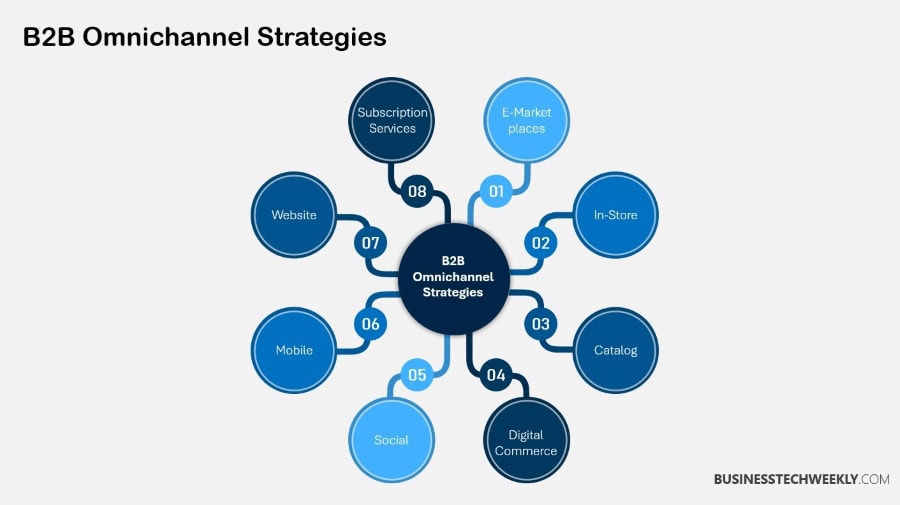
Key Trends in B2B Omnichannel eCommerce
As B2B eCommerce expands its omnichannel strategies, look for a deep commitment to meeting customers wherever they may be.
For one, they create a streamlined experience regardless of channel. By prioritizing everything around the customer, organizations will increase the satisfaction of the buyer, increase return visits to buy, and produce quantifiable results.
Here are the key trends driving this space.
1. Tailor Experiences to Each Customer
The personalization is the cornerstone of a strong omnichannel approach.
Tools like CRM systems and marketing automation platforms enable you to centralize customer data, segment audiences, and tailor interactions based on individual preferences.
For instance, providing tailored product suggestions or prompt post-purchase follow-ups can build trust and loyalty in the b2b market.
Choosing eCommerce platforms that facilitate omnichannel b2b commerce capabilities, such as unified inventory management and multi-channel order management, further simplifies operations. Data analytics plays a crucial role and makes a significant difference.
Using reporting tools like Profit Bandit allows you to take action and gain tangible insights into customer behavior, sales performance, and channel effectiveness.
For example, measuring metrics such as customer acquisition cost or average order value can help adjust and optimize your B2B omnichannel marketing strategy to achieve goals more effectively.
This data-driven approach empowers you to predict customer needs and optimize the buying journey.
2. Use New Sales Technology
Modern sales tools are invaluable for tracking and iterating on omnichannel strategies.
Having key performance indicators, be it conversion rates or customer retention, serves as an effective barometer on how far you’ve come. When analyzed, these metrics can reveal opportunities waiting to be seized, like channels that are underperforming or markets that are currently untapped.
Implementing AI-powered tools helps cut time and complexity out of the sales cycle. Predictive analytics, for example, can help businesses anticipate demand based on historical buying behavior, allowing for more strategic inventory control.
Continuing their business automation theme, these technologies simultaneously improve the customer experience with greater speed and accuracy.
3. Grow Digital Sales Channels
In today’s rapidly changing, competitive landscape, expanding your digital footprint is a must.
Whether that’s social commerce, marketplaces, or DTC, expanding your reach can help you access the growing number of customer bases shopping in these channels.
For instance, adding options like one-click purchases or subscription models makes it easier to complete transactions, meeting the needs of today’s buyers.
4. Blend Online and Offline Sales
A strong omnichannel marketing strategy helps to create a more cohesive experience across all touchpoints.
Options such as click-and-collect or in-store returns for online purchases connect the two worlds and deepen customer engagement.
This integration not only enhances convenience but also builds trust with your brand, crucial for effective omnichannel sales.
5. Keep Data Clean and Connected
Keeping data deep and wide—well connected, complete, consistent—is essential to supporting the smooth running of all operations.
Centralized systems help keep inventory levels, customer information, and order history accurate across the board, leading to fewer errors and better informed decisions.
Accurate and up-to-date data ensures seamless, omnichannel customer experience that builds loyalty and keeps customers coming back.
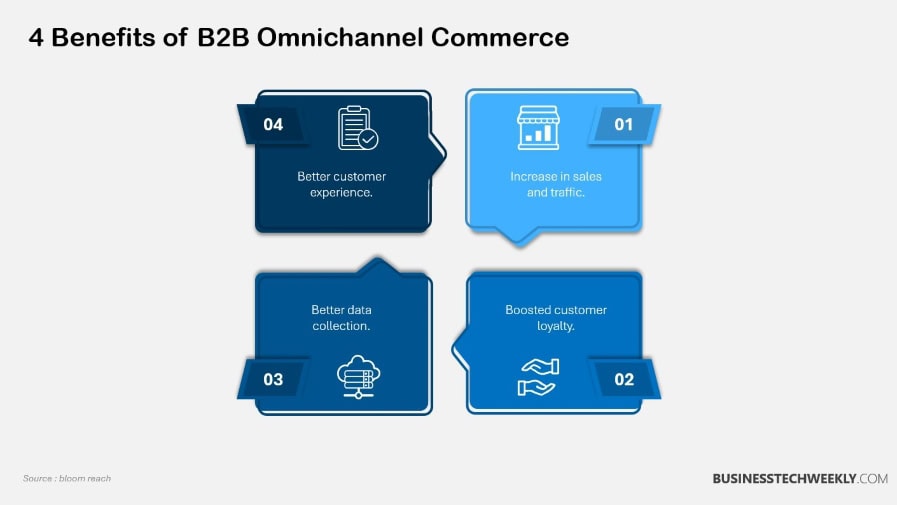
What Are the Benefits of B2B Omnichannel?
Implementing a B2B omnichannel approach revolutionizes the way companies do business. It allows them to scale, compete, and ultimately succeed in today’s dynamic landscape. By integrating multiple channels into a cohesive experience, your business can unlock new opportunities, strengthen customer relationships, and improve operational effectiveness.
Let’s take a look at each of these benefits.
1. Sell More and Increase Revenue
With an omnichannel approach, your B2B business can deliver more consistent and convenient omni-device purchasing experiences that customers now seek. For example, your customers can start a purchase on your website, receive personalized assistance through email or chat, and finalize the transaction via mobile.
This flexibility feeds into the desire for more flexible, self-directed buying journeys we’re seeing in all marketplaces.
It promotes larger order values. For example, it increases the likelihood that B2B buyers who interact through multiple channels will make bigger purchases, according to studies.
By uniting these touchpoints, you decrease fall-offs and increase conversions at each level of the sales funnel.
2. Make Customers Happier and More Loyal
B2B buyers have grown accustomed to the level of intuitive use and personalization that they receive in B2C interactions.
Fostering trust and transparency consistency across touchpoints—such as confirmed pricing, up-to-date inventory availability, and personalized recommendations—fosters customer trust.
When a customer discovers same, accurate product information across your app and in conversations with your sales team, they experience instant trust.
Next, this confidence makes them more likely to return to you next time
Satisfied customers are more likely to refer your company, fueling organic growth through word-of-mouth referrals.
3. Run Your Business More Efficiently
Omnichannel strategies simplify operations through the integration of technology such as customer relationship management (CRM) software, inventory management systems, and AI-driven analytics.
These tools offer in-depth analytics and reporting that run from customer transactions to back-office operations.
Take automated order tracking and centralized data, for example. Automating these processes lowers manual error and frees your team’s time and resources.
In exchange, this efficiency creates space for you to prioritize intentional, strategic growth over damage control from preventable errors.
4. Gain an Advantage Over Others
It’s no secret that in competitive markets, or pretty much any market, differentiation is key.
A well-executed omnichannel presence shows your B2B business as modern and customer-centric, and this might help sway the decision when it comes time to secure contracts.
When your competitors are still using antiquated, siloed systems, your agile, all-in-one solution shines through as the smarter, more flexible option that customers trust.
5. Expand Your Market Reach
With omnichannel, those geographic limitations become postage stamp sized. With digital touchpoints through e-commerce, virtual demos, and more, it’s never been more convenient to engage with prospects around the world.
By providing multilingual support and region-specific payment methods, you make your services more attractive to a wider range of customers.
This strategy unlocks access to emerging markets and accelerates expansion.
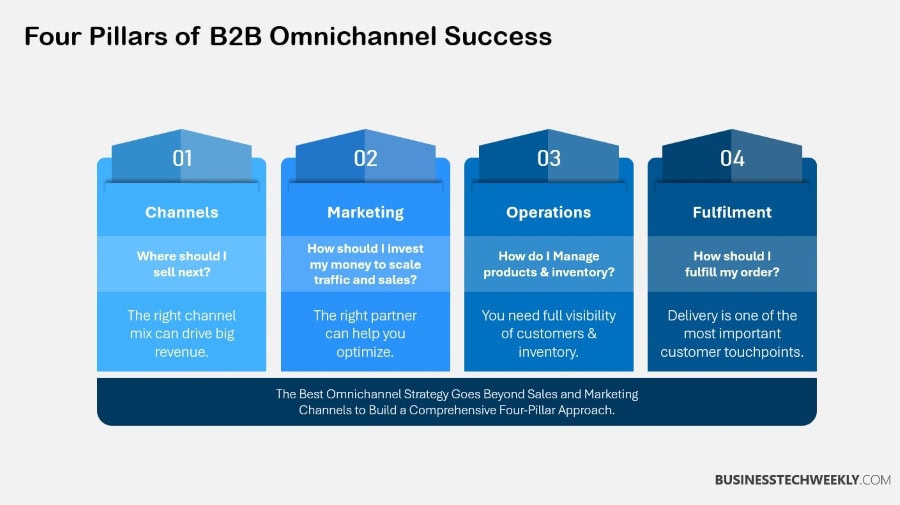
How to Start with B2B Omnichannel eCommerce
Starting with a strong omnichannel marketing strategy for B2B omnichannel eCommerce requires a structured approach to ensure all aspects of your business align with customer expectations and operational efficiency.
By breaking this process down into actionable steps, you can more easily make decisions that enhance the seamless customer experience and position your business for future growth.
1. Evaluate Current Business Processes
Step one is to take a hard look at your current workflows, toolset, and customer touchpoints.
Take a good hard look in the mirror at your supply chain’s practices. Consider how orders are fulfilled and how your sales team interacts with customers.
Pinpoint where in the process manual work or siloed systems are creating bottlenecks.
Without proper omnichannel integration, like if your inventory management system can’t sync with your order-processing tools, you’ll risk shipment delays. This misalignment can lead to stock discrepancies too.
Identifying ways to streamline these additional processes will pave the way for an easier transition to omnichannel operations.
Consider compliance requirements for your industry. As regulations evolve, staying ahead minimizes risks.
For instance, businesses in the healthcare sector must ensure data handling aligns with HIPAA standards. Evaluating these areas early helps future-proof your strategy.
2. Know Your Audience and Their Needs
Knowing who you’re speaking to and what they need to know is the foundation of any good omnichannel approach.
B2B buyers have different expectations. They tend to look for comprehensive product specifications, volume ordering capabilities, and customized pricing.
Implement analytics tools to determine purchasing trends and customer feedback to see what clients are least and most satisfied with.
If your customers enjoy ordering via mobile, then you need to ensure you can meet them in this channel.
Further, prepare your email customer support to support these customers post purchase. Meeting their need with an approach that aligns with their preferences drives immediate customer satisfaction and cultivates future long-term loyalty.
3. Select the Right Platform
Deciding on a platform specifically designed for B2B omnichannel commerce is critical. Platforms like Shopify Plus, BigCommerce, or Magento offer robust features such as custom catalogs, flexible payment options, and integrations with CRM tools.
Make sure that the solution you choose is scalable and easy to integrate with your current systems.
For instance, if your business relies heavily on ERP systems for inventory and finance management, ensure the platform supports real-time data syncing.
This prevents repetitive labor and makes sure that the business runs smoothly.
4. Put Your Strategy into Action
After you’ve set the foundation, it’s time to activate. The best place to start is to get your new platform connected with your current channels—be that your website, mobile apps, or even brick & mortar sales.
Educate your staff on the proper use of new tools so they can deliver the best experience possible across all touchpoints.
Provide your sales team one customer-facing, background system.
This way, they can easily view and manage client accounts, order histories, and product details while on the move. This equips them to better meet customer needs with the right solutions and win deals more quickly.
5. Track and Analyze Your Progress
Lastly, determine your KPIs to define what success looks like and how you’ll measure it within your b2b omnichannel marketing strategy.
Metrics such as customer retention rates and average order value provide actionable insights for your omnichannel marketing approach.
Additionally, monitoring the average time to fulfill orders allows you to assess how well your omnichannel b2b commerce strategy is working.
Use platforms such as Google Analytics or the analytics dashboard offered by each platform to track key data points on a consistent basis.
For example, if you see a decline in mobile orders, look into if your mobile site could use some improvement.
By keeping a constant eye on these metrics, you can stay agile and one step ahead of your competition.
Common Challenges in B2B Omnichannel
While the potential of a successful omnichannel B2B marketing strategy is vast, so are the challenges involved that require dedicated focus.
Overcoming these omnichannel B2B challenges is key to creating an efficient, seamless omnichannel experience and scalable operation.
Here’s where businesses typically stumble the hardest, and real-world advice on how to get past these pitfalls.
1. Connect and Manage Data
In an increasingly B2B omnichannel environment, integrating these data sources is fundamental.
Most companies have a hard time with fragmented systems that isolate the customer, sales, and inventory data across multiple platforms. This separation hampers not only decision-making, but operational efficiencies needed to thrive in today’s environment.
Centralizing data with a strong ERP or CRM system can help make this easier.
Connecting an enterprise cloud-based platform like Salesforce or NetSuite creates uniformity amongst all your channels. From your e-commerce websites to brick-and-mortars, they’ll all be working with real-time intelligent data.
Automatic data synchronization eliminates costly human errors, streamlining workflows and empowering better business decisions with consistent, accurate data.
2. Keep Customer Experiences Consistent
Customers expect the same level of service regardless of whether they engage online, through a mobile app, or directly with a sales team.
Inability to provide a seamless experience breaks down trust and loyalty. For instance, if there are pricing differences between your site and brick-and-mortar stores, shoppers will get frustrated and leave their carts.
Integrating unified pricing models and customer support platforms such as Zendesk ensures you maintain the same quality interactions across channels.
Having a loyalty program that tracks customer rewards no matter where they buy can further deepen that customer happiness and loyalty.
3. Overcome Internal Barriers
We often find that internal resistance is the biggest challenge to adopting omnichannel strategies.
Departments in your organization work in silos, or perhaps your teams don’t have the expertise to effectively steward these new technologies. Promoting a culture of collaboration with cross-functional teams and training programs for employees will help to dismantle these silos.
Conduct frequent training sessions to equip your staff.
Offer them access to certifications in platforms such as HubSpot or Shopify Plus so they feel empowered to embrace new ways of working and directly support business objectives.
4. Track Inventory in Real-Time
This is a major challenge for many B2B businesses. Without accurate, real-time information, overstocking or understocking can throw a wrench in operations.
PRO TIP: Solutions such as RFID technology or inventory management software like TradeGecko can offer instant visibility.
These tools notify you when stock reaches a certain threshold, and they even help you predict demand, cutting down on redundant processes and making supply chain management more effective.
5. Manage Tech and Costs
Implementing omnichannel strategies typically requires heavy technological investment, which can stretch budgets thin.
Opting for more scalable, SaaS-based solutions such as BigCommerce or WooCommerce allows businesses to begin on a smaller scale and grow the platform as necessary.
Consider platforms with modular pricing so you’re paying only for the features your business needs now and can add on in the future.
Tracking ROI means every dollar you invest makes a direct impact on your bottom line.
Mapping the B2B Customer Journey
Perhaps no one thing is more important than understanding the B2B customer journey.
Today’s business buyers expect B2B experiences on par with leading B2C brands. In contrast to the much shorter and more linear B2C path, B2B journeys can take several months, with multiple influencers and decision-makers along the way.
Mapping this journey strategically helps you maintain a cohesive experience across all touchpoints, increases customer satisfaction, and fuels sustainable growth.
Understand B2B Customer Touchpoints
B2B customer journeys are complex, multifaceted paths with touchpoints that vary from digital engagements to in-person gatherings.
These touchpoints go beyond just influencing the final purchase decision—they impact the customer experience through every stage in the lifecycle, from awareness all the way through post-purchase support.
It takes a long with a lot of input from procurement teams, managers, and executives. It’s essential to find ways to continue meeting the needs of each stakeholder in play.
For example, a SaaS provider selling to mid-sized enterprises may engage with IT departments for technical discussions, finance teams for budget approvals, and end-users for product demonstrations.
Mapping out these touchpoints gives you the ability to strategically develop messaging and resources, so everyone involved has a clear and consistent experience.
With 44% of millennials preferring to avoid direct sales interactions, self-service options such as intuitive websites, product demos, and detailed FAQs have become critical touchpoints.
Optimize Each Stage of the Journey
The only way to truly optimize the journey is to ensure relevant, seamless, and compelling experiences take place at every level of the journey.
Begin by using buyer personas—semi-fictitious representations of your segments—to learn about their priorities and roadblocks. This is essential for an effective omnichannel marketing strategy.
Add in first-party data, such as website engagement and previous buying behavior, to fine-tune these personas and provide customized solutions.
Brands like Slack and Stripe have raised the bar in omnichannel b2b commerce. They combine functionality with compelling aesthetics, flaunting designs and usability as good as the consumer apps we’ve all grown to love.
This unified approach to customer experiences not only engages potential customers to choose you initially but also fosters loyalty in the long run.
Hearing out, not just overlooking judgment aside, listening to feedback is just as vital. Continually gathering and acting on customer feedback keeps the omnichannel customer journey precise, increases satisfaction, and improves retention.
Incorporating stakeholders into the mapping process is another important tactic.
These responsibilities at each touchpoint will help guarantee that your customers are taken care of at each and every engagement.
Whether it be during the technical onboarding phase or post-sale support, clear ownership reduces room for gaps and builds trust with the customer’s team.
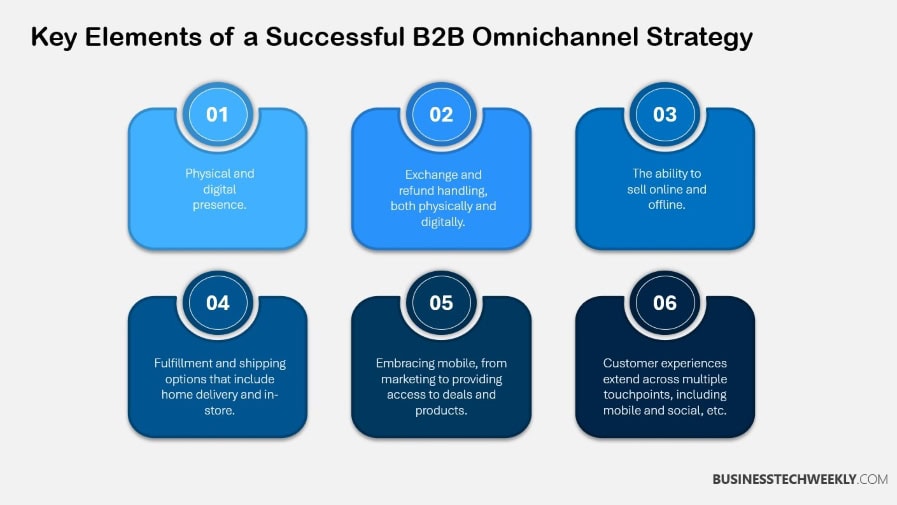
Essential Technologies for B2B Omnichannel
In the high-stakes, competitive world of B2B today, a strong omnichannel marketing strategy is no longer an option—it’s a necessity.
To survive, businesses must leverage essential technologies that enable seamless omnichannel experiences. This approach allows them to deliver a consistent and effective experience across all channels, from the first contact to after-purchase service, fueling successful omnichannel ecosystems.
CRM and Marketing Automation
Customer Relationship Management (CRM) and marketing automation systems are the glue that holds successful omnichannel strategies together.
These tools enable businesses to manage customer data across multiple channels, ensuring consistency and personalization at every stage of the journey.
By integrating CRM with email and social media, you can unlock deeper, more actionable insights.
This method allows you to customize campaigns and programs to different customer types. Salesforce and HubSpot are widely recognized for their robust capabilities in this space, offering features like customer journey mapping and automated workflows.
A Monetized Net Promoter System (NPS) can further enhance your CRM by quantifying customer loyalty and identifying areas for improvement.
When you couple a closed-loop process with specific goals, you equip your business to improve customer experiences.
With this approach in place, your retention rates will increase dramatically as well. This should come as no surprise, given that 75% of B2B customers are more likely to repurchase from those suppliers offering omnichannel capabilities.
eCommerce Platforms and Integrations
Leading platforms like Shopify Plus and BigCommerce allow seamless integration with key channels, such as websites, email, and social media, ensuring a cohesive shopping experience.
Features such as track-and-trace functionality are table stakes for B2B stores, as they provide end customers with real-time visibility into their orders, helping to reduce fulfillment friction.
Chatbots and other AI-driven tools are central to this, delivering consistent, real-time support on any channel customers choose.
These technologies provide customers the ability to pick up their journey seamlessly from wherever they left off, improving experience and increasing confidence.
Data Analytics and Reporting Tools
Data analytics tools are absolutely essential to understanding how you’re doing and shaping your strategy.
Tools such as Google Analytics and Tableau give you data-driven insights into your customers’ behavior so you can spot patterns and optimize how you engage with them.
By implementing customer journey mapping and aligning data insights across departments, you can create a unified approach that aligns with customer needs.
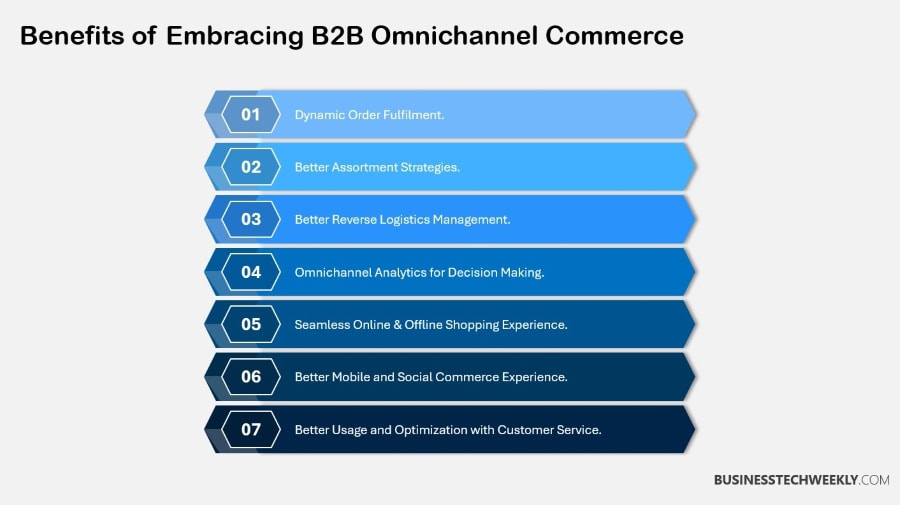
Measuring Omnichannel Success in B2B
Measuring the effectiveness of an omnichannel strategy in B2B markets requires a clear understanding of customer behavior, preferences, and engagement across all touchpoints.
Whether we’re talking about the retail or B2B space, this strategy leverages a customer-centric approach. It strives to provide integrated, cohesive experiences that build confidence and allegiance.
Use these important metrics and actionable insights to measure your omnichannel success.
That will give you an idea of how successful you are at meeting your business growth goals.
Key Performance Indicators (KPIs) to Track
To measure the success of your omnichannel strategy, begin with determining which KPIs to focus on.
Equally essential, advanced metrics such as Net Promoter Score (NPS) provide deep insights into customer loyalty and advocacy.
To arrive at NPS, you simply take the promoters percentage and subtract the detractors.
This approach gives you a simple, straightforward metric to gauge how likely customers are to recommend your company.
A high NPS indicates that your customers are happy. It helps uncover strategic high-value opportunities for customer/partner referral campaigns that fuel the flywheel of organic growth.
The second major piece is measuring how omnichannel capabilities and experiences influence repeat-purchase behavior.
According to McKinsey, 75% of B2B customers are more likely to buy again through suppliers that have fully implemented omnichannel systems.
Tracking customer retention rates and evaluating the willingness to recommend can provide a clearer picture of how your strategy fosters long-term loyalty.
Focusing on touchpoints after the first purchase—such as timely follow-ups or personalized offers—can enhance the overall experience and deepen relationships with clients.
Analyze Data to Improve Performance
Data analysis is key in fine-tuning your journey across the omnichannel landscape. Begin with an analysis of how NPS drivers map to key business functions.
First, swift response is key to increasing your promoter and passive scores.
By making sure your team is closing this loop within 48 hours, you are 12% more likely to retain them. This method wins businesses the loyalty of their customers.
Further, it calls attention to how important speedy, efficient communication is to gaining loyalty.
In addition, customer journey analytics can identify where the omnichannel experience falls short. Measure touchpoints from email to social, to live experiences to make sure you’re showing up in a unified manner.
Improve the poor spots and shore up the good ones. Taking this approach will enable you to develop a strategy that goes above and beyond customer expectations.
Key Points to Note
- An omnichannel approach in B2B increases customer satisfaction and loyalty. This strategy enables real-time, uninterrupted and tailored experiences both online and offline at every touchpoint.
- Integrating online and offline sales channels creates a cohesive shopping journey, helping you meet diverse customer preferences and drive better sales results.
- Increasing your digital sales channels helps your business be more competitive, gain a bigger share of the market, and meet the evolving expectations of buyers today.
- By leveraging advanced sales technologies and data analytics, you can gain actionable insights that empower you to optimize performance and make data-driven decisions.
- Unifying customer experiences across every channel not only protects brand integrity, but it establishes trust and loyalty that keeps your customers coming back for years to come.
- Evaluating and improving internal processes while overcoming operational barriers ensures your omnichannel strategy is efficient and aligned with your business goals.

